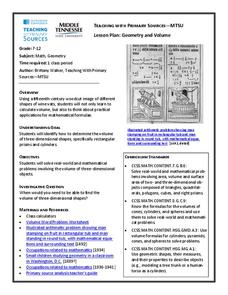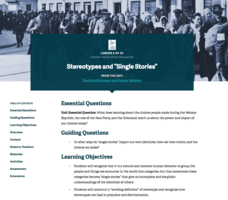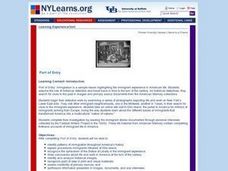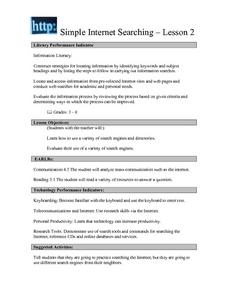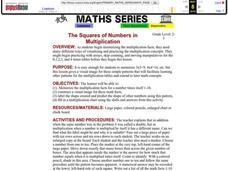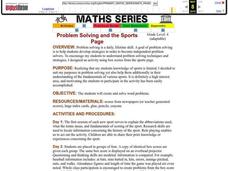IPDAE
Themes in Short Stories
"What is the theme of this story?" The very question can spark fear in the minds of readers and incinerate confidence. Here you will discover an exercise that shows how writers use the tools of setting, plot, conflict, and...
St. Joseph Community Consolidated School District #169
Nutcracker
'Tis the holiday season and the Clara, the Sugar Plum Fairy, and the Nutcracker Prince come alive with a teaching and study guide for Tchaikovsky's famous ballet. Background information, activities, games and puzzles are all included in...
Curated OER
Circular Flows
To study circular flow, learners use the plans to trace through a series of interconnected economic and financial flows to explain the workings of the American economy. They use the model developed to comprehend the effects of Federal...
Virginia Department of Education
Geometry and Volume
The history of math is fascinating! Utilize a woodcut primary source image from 1492 and posters from the 1930s to help geometers apply their volume-calculation skills to real-life questions.
Facing History and Ourselves
Tactics of Nonviolence
High schoolers analyze the direct action tactics of nonviolence. As a class, they distinguish between a strategy and a tactic and identify tactics used during the civil rights movement. They relate these tactics and how they might be...
Curated OER
Rediscovering Forgotten Women Writers
Women's voices are becoming more prominent in the world of literature, but for centuries, this wasn't the case. Young historians research a woman whose writings are considered to be lost, out of print, or forgotten. They develop an oral...
Facing History and Ourselves
Decision-Making: Introduction to the Unit
Make your classroom a supportive and communicative place to be before beginning a unit on the Holocaust. Working together as a class, learners reflect on their previous experiences of classroom discussions before establishing a...
Facing History and Ourselves
Stereotypes and “Single Stories”
Help bring subconscious stereotypes to the surface to stop it in its tracks. Pupils first read an excerpt describing the experience of prejudice and analyze how this process connects to World War II. Then, they write a creative story...
Curated OER
Tree-Mendous!
Learners classify trees. In this tree-mendous lesson, students categorize a variety of trees to assist them in playing a Jeopardy like game. Learners identify new vocabulary terms and classify the uses and benefits of trees for...
Curated OER
Port of Entry
Students research patterns of immigration throughout American history. The focus is on the process of how immigrants came through Ellis Island. Students reflect upon the topic to develop critical thinking skills.
Curated OER
Simple Internet Searching Lesson 2
Learn how to use search engines and keywords! Learners evaluate the information process using given criteria and determine ways in which the process may be improved.
Curated OER
ReReading America Lesson Three: Hands-on Practice
Students research, using a variety of sources, a topic that has been previously chosen. They evaluate their information for the value, relevance, and accuracy. Students identify problems in their research and writing to get assistance as...
Curated OER
The Squares of Numbers in Multiplication
Review multiplication facts and concepts! This clear, and easy to follow lesson will help your class to understand multiplication by using arrays and repeated addition. There are strategies to help with memorization and manipulative...
Curated OER
Problem Solving and the Sports Page
The use of box scores from baseball games is the foundation of this math lesson. Organize your class into groups of four, and give identical box scores from a baseball game that was just played. Have them create word problems from the...
Curated OER
Usage and Interpretation of Graphs
Cooperative groups are formed for this graphing activity. Each group must construct a graph that represents how many eyelets (the holes for laces in shoes), are present in their group. A whole-class bar graph is eventually constructed...
Curated OER
Is That a Fact?
Investigate popular scientific claims and gather evidence to defend or argue against an author's stance. Writers synthesize information and compose their own "Really?" columns modeled after those found in the weekly "Science Times"...
Curated OER
Pay to Play?
Lead your class in a discussion about how they believe money influences politics. After reading "Go Ahead, Try to Stop K Street" from the New York Times, they evaluate the claims in the article about the current lobbyist scandal in...
Curated OER
E.T., Are You Out There?
Research the necessary components of a planet that supports life after reading the article "All of a Sudden, The Neighborhood Looks a Lot Friendlier" from The New York Times. After finding their information, middle and high schoolers...
Curated OER
Design a Coin
Young scholars research a state and then design a quarter for it. They use dough or foil to create the coin! students explore state quarters that have already been issued by the U.S. Mint. Their quarter is for a state that hasn't had one...
Curated OER
Digital Kids Club
Students create a slideshow on a chosen subject. They connect to the subject matter through images from the Internet, books, or pictures they have taken. Students convey the emotions the topic elicits and demonstrate understanding of the...
Curated OER
Class Book Awards
Learners create a class book award. In this book award lesson, students review the book awards already created (Caldecott or Newbery) and look at books that have received these awards. They come up with their own award and nominate new...
Curated OER
"I Hear America Singing": Controversy and Music in the Mexican War
Eighth graders examine the Mexican War and its outcome through music. In this primary source analysis lesson, 8th graders analyze the lyrics of selected songs to consider the 2 perspectives regarding U.S. involvement in the war. Students...
Curated OER
Classifying Items
In this classifying worksheet, students read about grouping similar objects into categories based on similarities. They determine how the groups are related and they draw a diagram showing categories and subcategories.
Curated OER
Mixed Media Landscape Design
Seventh graders create mixed media representations of landscape designs in Africa and Asia. The lesson is great for cross-curricular projects with the Social Sciences and/or Literature, or can be used as a self-contained project. ...



